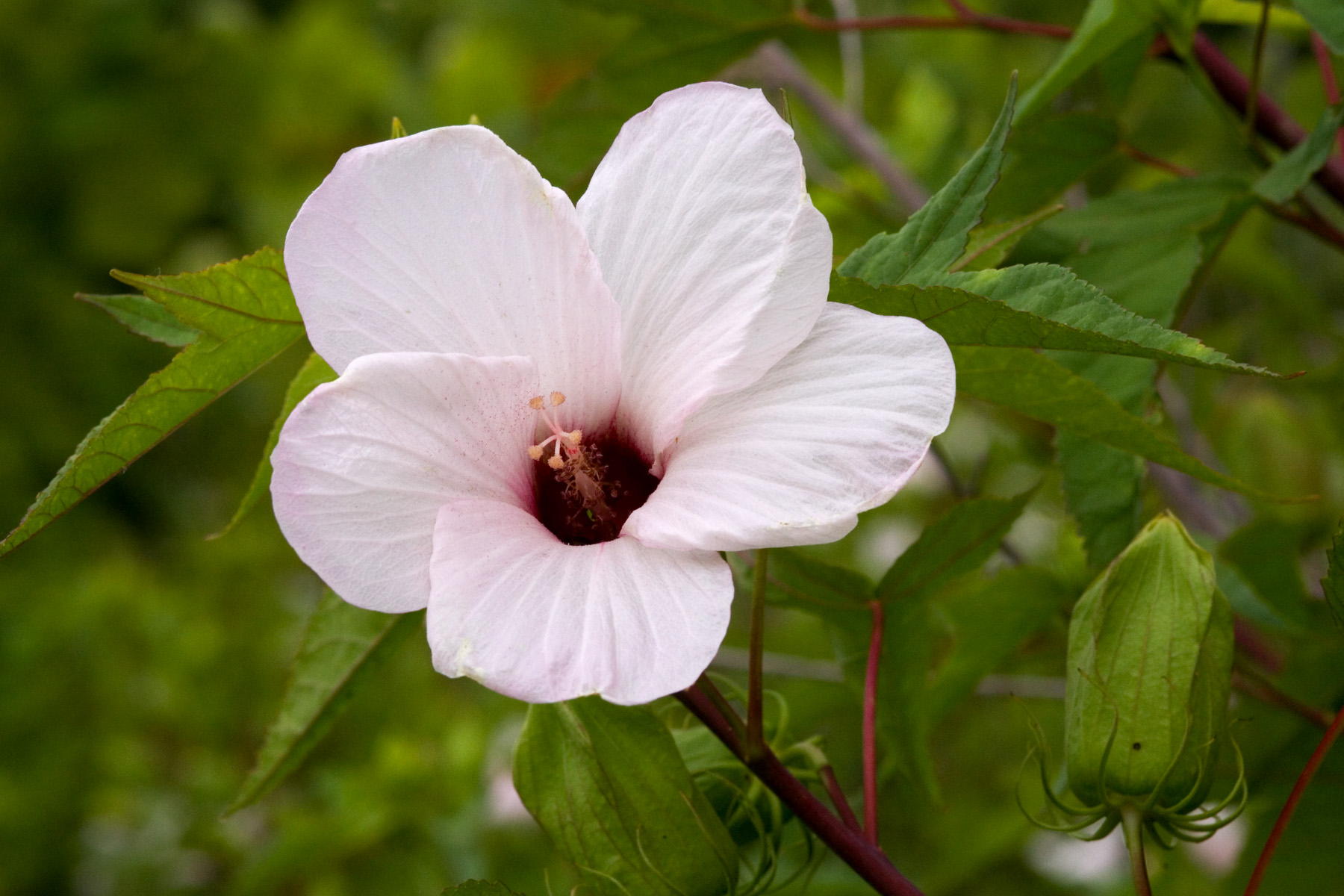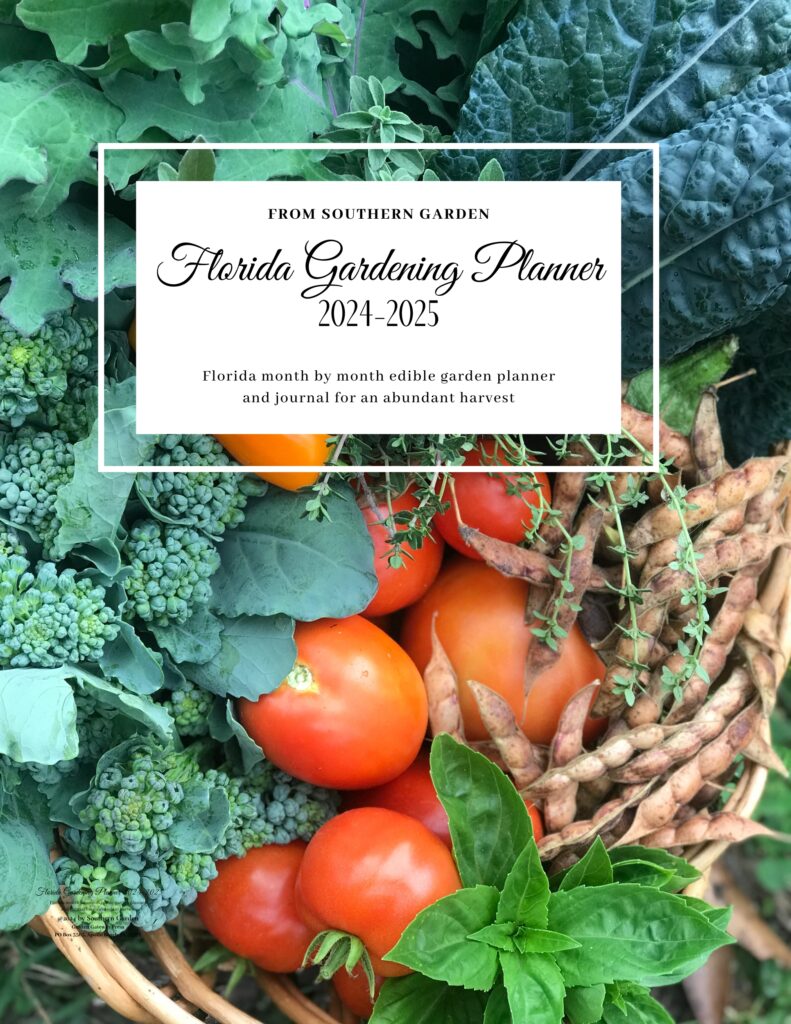Halberd-leaf rosemallow (Hibiscus laevis), sometimes called halberdleaf hibiscus, smooth rose mallow, or simply wild hibiscus, is a native perennial wildflower belonging to the mallow family, Malvaceae. This striking wetland species is native to central and eastern North America, and growing Halberd-leaf Rosemallow is a great way to transition your landscape into a more wildlife-friendly garden.
Halberd-leaf rosemallow thrives in lowland habitats such as swamps, wet meadows, ditches, and streambanks. The species name laevis refers to the smoothness of its stems and foliage. Often mistaken for tropical hibiscus, halberd-leaf rosemallow is a cold-hardy, herbaceous perennial that can be grown from seed and cultivated with relative ease in gardens that mimic its moist, sunny native habitats.
Halberd-leaf rosemallow grows well in USDA Zones 4 through 9. It performs best during the warm seasons, particularly in spring and summer, when it puts on vigorous vegetative growth followed by a stunning floral display. The large, five-petaled flowers bloom over an extended period in midsummer, typically July through September, drawing the attention of gardeners and pollinators alike.
Growing Halberd-leaf Rosemallow in Your Landscape Design

While native to wetland environments, this adaptable plant can thrive in garden beds with average to moist soils, making it a favorite among native plant enthusiasts, wetland restorers, and home gardeners seeking a low-maintenance perennial with high ornamental value.
This wild hibiscus is popular in rain gardens, pollinator patches, and habitat restoration projects. Its large, rose-pink flowers attract native bees, butterflies, and hummingbirds, while its sturdy stems and foliage add structural height and texture to garden beds.
Halberd-leaf rosemallow is also prized for its tolerance of clay soils and occasional flooding. Home gardeners often choose this plant for its ability to fill in low, wet, or seasonally soggy spots with bold, beautiful color.
Halberd-leaf Rosemallow Lifespan
Halberd-leaf rosemallow is a herbaceous perennial, returning each year from its roots after going dormant in the winter. In garden settings, it will often self-seed modestly under the right conditions, especially in moist soils that remain undisturbed.
It begins actively growing in late spring, often after many other perennials have emerged, and continues to bloom well into late summer. Its life cycle and long flowering period make it a strong candidate for long-term, low-input garden planning.
Big Blooms in the Wetlands: What to Expect from Halberd-leaf Rosemallow
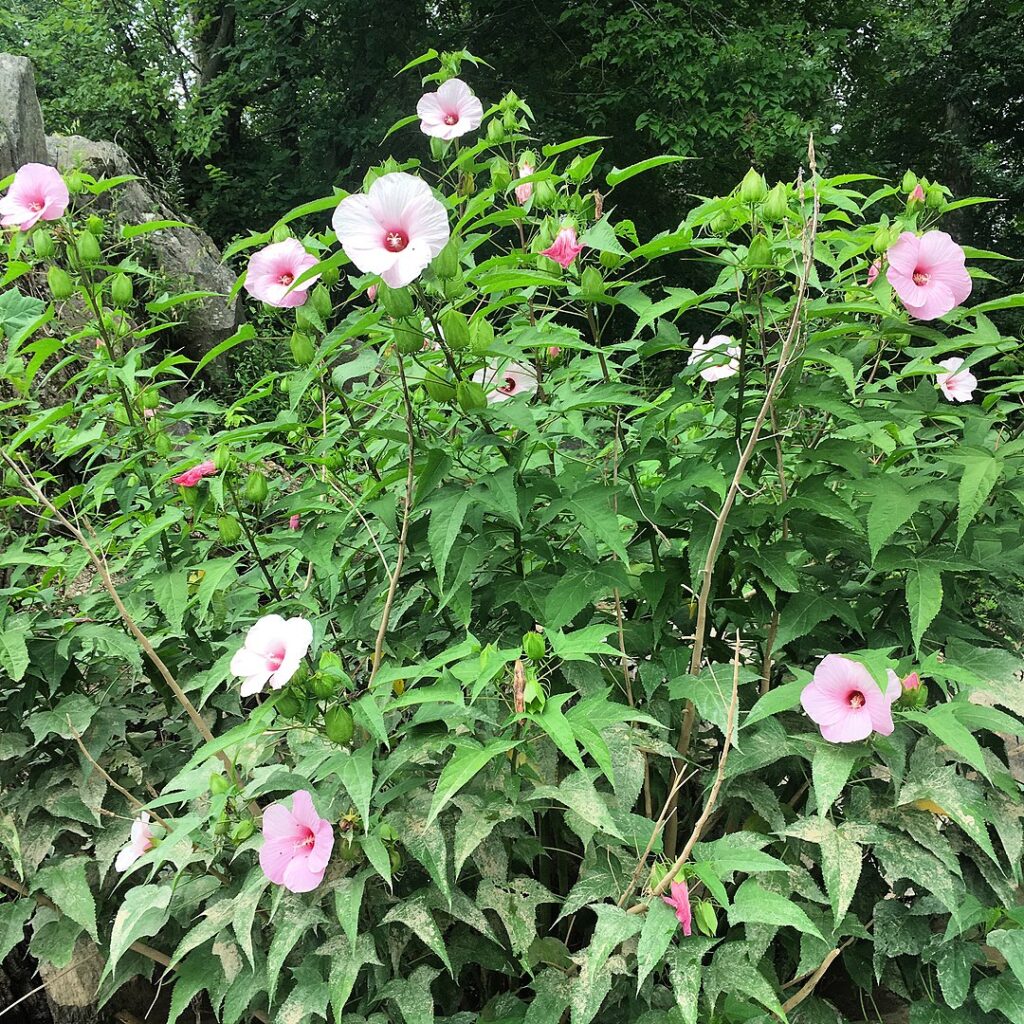
Halberd-leaf rosemallow is a statuesque perennial that brings a bold presence to garden beds, wetlands, and water’s-edge plantings. At maturity, it typically reaches between 4 to 6 feet tall, though in ideal conditions it may stretch up to 7 feet.
Its spread is more modest—usually 2 to 3 feet wide—making it an excellent vertical accent in the landscape. The plant grows on sturdy, upright stalks with branching tops, creating a bushy, vase-shaped silhouette that holds its large flowers high for pollinators to find.
Each plant produces numerous five-petaled blooms in shades of rose-pink to deep pink, sometimes with reddish centers. The flowers are typically 4 to 6 inches across and appear singly in the leaf axils along the upper stems.
Blooming begins in mid- to late summer and continues into early fall. Each individual flower lasts only a day, but the plant produces a steady stream of blooms for weeks on end, creating a long season of interest and a continuous nectar source for pollinators.
Halberd-leaf Rosemallow at a Glance:
- Lifespan: Herbaceous perennial
- Mature height: 4 to 6 feet (may reach up to 7 feet in ideal conditions)
- Spread: 2 to 3 feet wide
- Growth habit: Upright, multi-stemmed, vase-shaped form
- Bloom color: Rose-pink to deep pink, sometimes with red centers
- Bloom size: 4 to 6 inches wide
- Bloom time: Midsummer to early fall
- Foliage: Deep green, halberd-shaped leaves with three prominent lobes
- Days to maturity from seed: Typically blooms in the second year when grown from seed
- Sun requirements: Full sun to light shade
- Moisture needs: Medium to wet soils, tolerates seasonal flooding
- Soil type: Rich loam, clay, or sandy loam with organic matter
- Pollinators: Attracts bees, butterflies, and hummingbirds
- Special features: Self-seeds under suitable conditions, deer-resistant, native to eastern and central North America
When to Start Growing Halberd-leaf Rosemallow from Seed
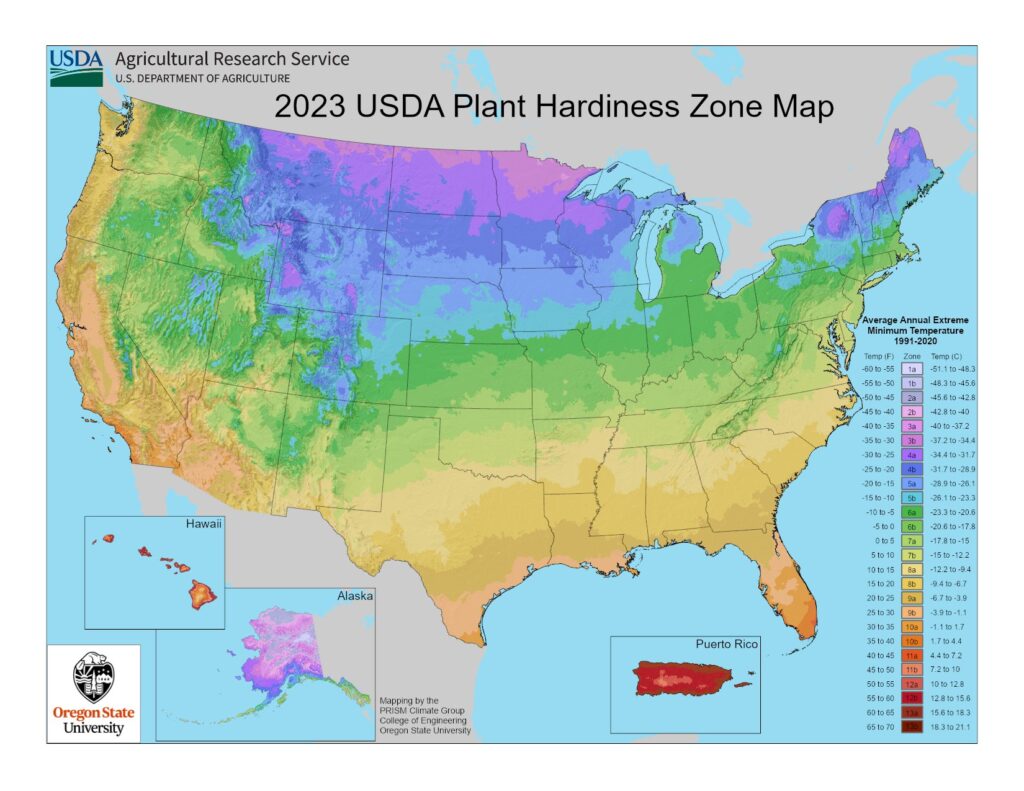
Halberd-leaf Rosemallow thrives when planted at the right time for your region. This native perennial needs warm soil temperatures to germinate, so both indoor seed-starting and direct sowing must be timed with the last frost date and the warming of the soil. Gardeners in cooler climates will have better success starting seeds indoors, while those in warmer regions can take advantage of longer growing seasons for direct sowing.
Cooler Zones 3–5:
- Start seeds indoors 8–10 weeks before your last expected spring frost.
- Transplant outdoors only after the danger of frost has passed and the soil has warmed to at least 65°F.
- Direct sowing outdoors is not recommended in these zones due to shorter growing seasons.
Temperate Zones 6–8:
- Start seeds indoors 6–8 weeks before your last frost date to ensure earlier blooms.
- Alternatively, direct sow seeds outdoors once the soil has warmed in late spring and nighttime temperatures consistently stay above 55°F.
Warm Zones 9–12:
- Indoor seed starting is optional but may still give plants a head start for early summer flowering.
- Direct sowing can be done in late winter or early spring as soon as the soil warms.
- In frost-free areas, Halberd-leaf Rosemallow may also be fall-sown for early emergence in spring.
Germination Tricks for Growing Halberd-leaf Rosemallow
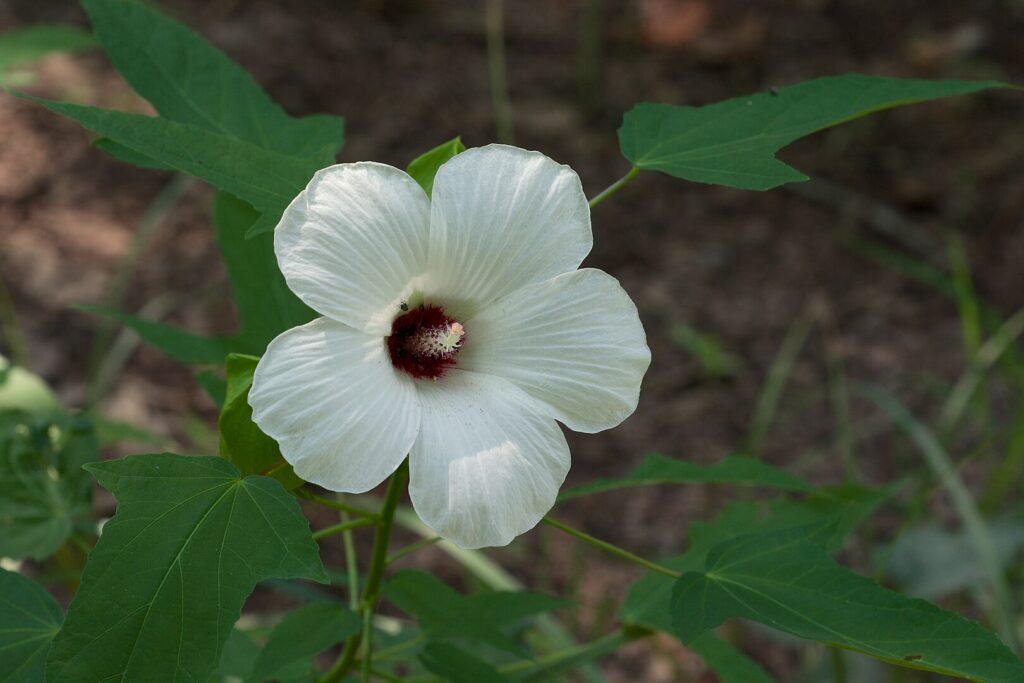
Halberd-leaf Rosemallow seeds can be slow to germinate without proper preparation. With the right pre-sowing techniques, you can greatly improve germination rates and encourage faster sprouting. Germination typically takes 14 to 21 days under optimal conditions, though it may take longer without treatment.
Cold Stratification
Halberd-leaf Rosemallow benefits from cold stratification, which helps simulate natural winter conditions and breaks seed dormancy. For cold stratification:
- Place the seeds in a damp paper towel or mix them with moist sand or vermiculite in a sealed plastic bag.
- Store them in the refrigerator (not freezer) at 38–45°F for 30 days.
- After the stratification period, plant seeds promptly.
Soaking
While not strictly required, soaking the seeds right before planting is highly recommended to soften the tough outer seed coat. To do this:
- Place seeds in a cup or bowl of warm (not hot) water.
- Let them soak for 12 to 24 hours before sowing.
- Drain and sow immediately after soaking.
Other Germination Tricks
Other tricks to encourage germination include:
- Using a heat mat to maintain a consistent soil temperature of 70–75°F.
- Sowing seeds in a warm, humid environment to mimic early spring conditions in their native range.
- Using a humidity dome or covering trays loosely with plastic to retain moisture while allowing air circulation.
Preparing the Garden Bed for Growing Halberd-leaf Rosemallow
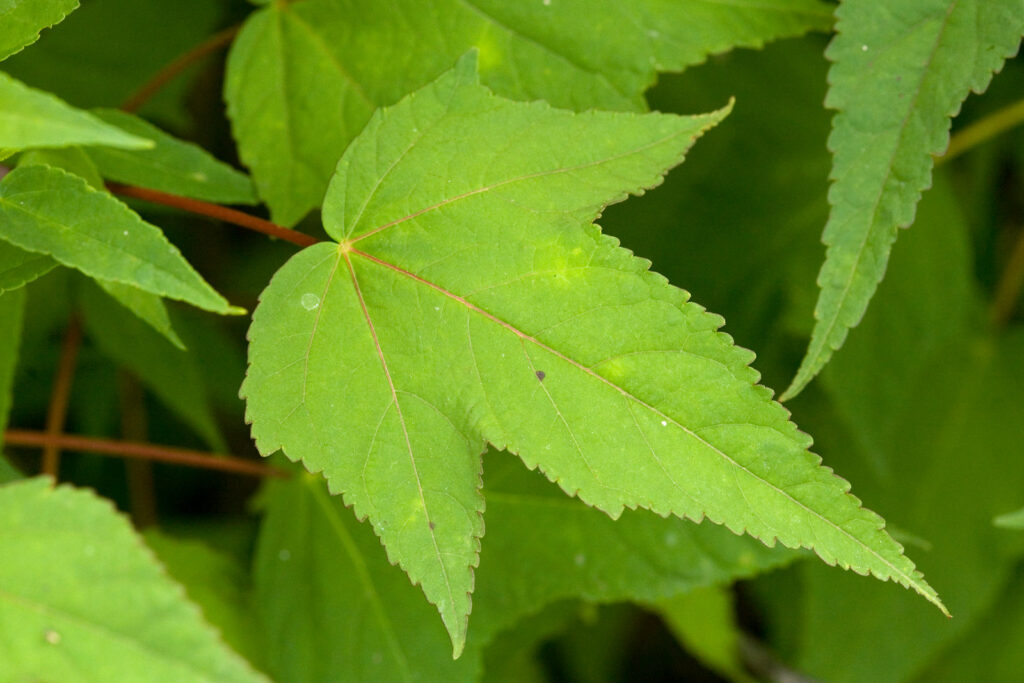
Before planting Halberd-leaf Rosemallow in the garden, it’s important to take the time to prepare a site that closely mimics its native environment. As a wetland plant, it thrives in rich, moist soils and full sun. Preparing the garden bed with this in mind will ensure strong, upright growth and a long blooming season.
Choosing a Location
Select a site with access to full sunlight for most of the day. Halberd-leaf Rosemallow will tolerate some light afternoon shade, especially in hotter climates, but too much shade will reduce flowering. This plant is naturally found along streams, pond edges, and in moist meadows, so areas with consistent moisture or even periodic shallow flooding are ideal.
Light Requirements
Halberd-leaf Rosemallow grows best in full sun, with at least 6 to 8 hours of direct sunlight each day. Plants grown in less sun may become leggy and produce fewer flowers.
Moisture
This species performs best in consistently moist or even wet soil. It is well-suited to rain gardens, swales, and other areas where water collects but drains within a few days. It also grows well near the edges of ponds or along ditches. If planting in drier areas, amend the soil to improve water retention and plan to irrigate regularly.
Direct Sowing Halberd-leaf Rosemallow Seeds
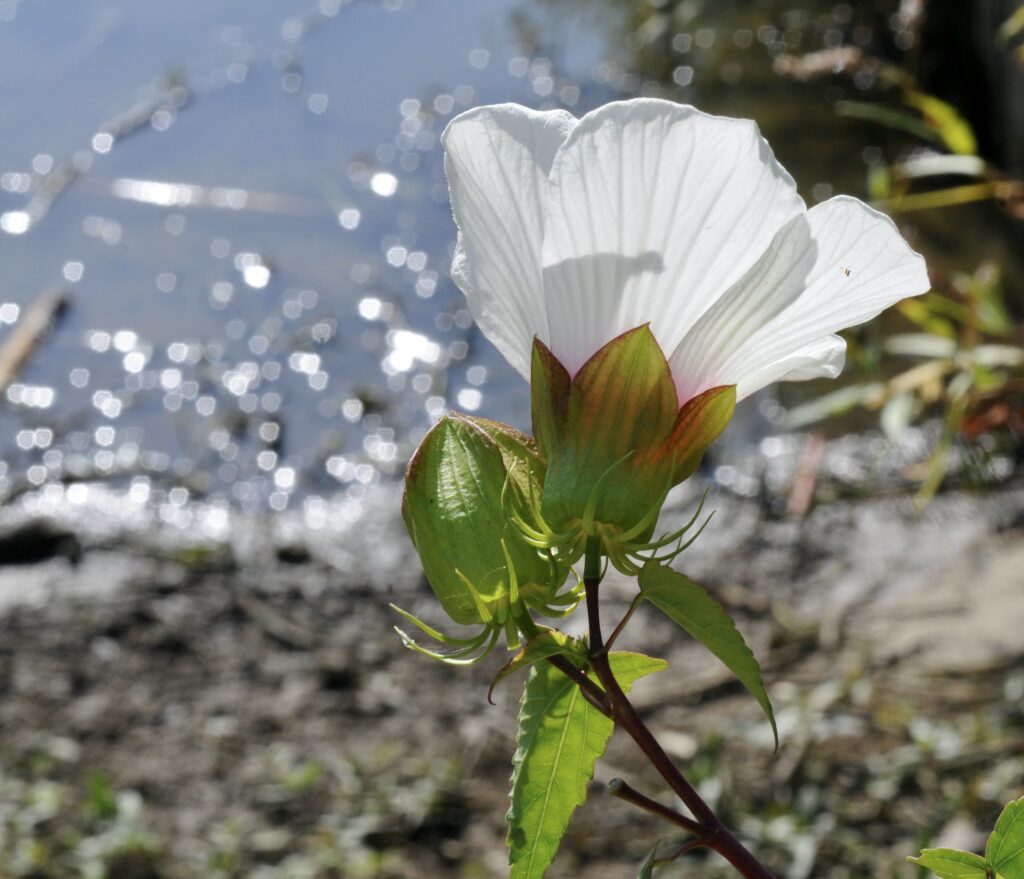
Direct sowing Halberd-leaf Rosemallow seeds outdoors is a straightforward method that works well when timed properly with seasonal conditions. To give your seeds the best start, follow these detailed steps.
Before planting, choose a garden area with moist, rich soil and good sunlight, as this will encourage healthy seedling development.
- Depth to plant: Plant the seeds shallowly, about ¼ inch deep. Lightly cover the seeds with soil or fine compost to keep them moist but not buried too deeply, which can inhibit germination.
- Moisture requirement for seeds: Keep the soil consistently moist after sowing. The seedbed should never dry out during germination, so water gently but regularly to maintain even moisture without waterlogging.
- Optimal temperature for germination: Halberd-leaf Rosemallow seeds germinate best at soil temperatures between 70 and 85 degrees Fahrenheit. Warmer soil speeds germination but avoid extremes that could dry out the seedbed.
- Time to germination: Germination typically occurs within 10 to 21 days but can sometimes take longer depending on soil conditions and temperature.
Starting Halberd-leaf Rosemallow Seeds Indoors
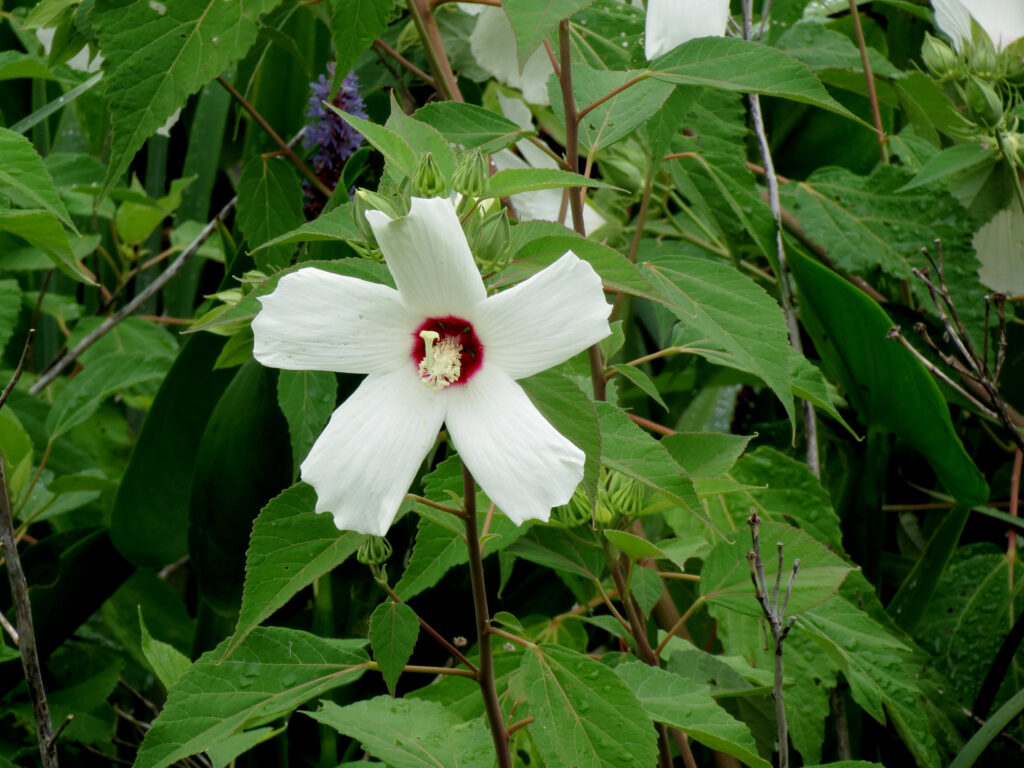
Starting Halberd-leaf Rosemallow seeds indoors allows for better control over germination conditions, giving seedlings a strong start before transplanting. Use cell trays or soil blocks to give each seed ample room to grow without disturbing roots during transplanting.
Starting Mix
To ensure the best results, prepare a seed starting mix that is light, well-draining, and rich in organic matter. A blend of fine peat moss or coco coir with perlite or vermiculite works well. Avoid heavy garden soil that can compact and hinder seedling growth.
Containers
Choose containers that are at least 2 to 3 inches deep. Cell trays with individual compartments or soil blocks are ideal because they provide good drainage and allow seedlings to develop strong roots.
Seed Depth
Plant the seeds shallowly, covering them with about ¼ inch of seed starting mix. This depth protects the seed while still allowing it to push through the soil easily.
Moisture
Keep the soil consistently moist but not soggy. Mist the surface gently or water from the bottom to maintain even moisture, which encourages healthy germination.
Temperature
Maintain an optimal temperature of 70 to 85 degrees Fahrenheit for germination. This warmth supports quicker sprouting and robust seedling development.
Germination generally occurs within 10 to 21 days under these conditions. Once seedlings develop their first true leaves and are sturdy enough to handle, they are ready for hardening off before transplanting.
When to Plant Out Halberd-leaf Rosemallow Plants
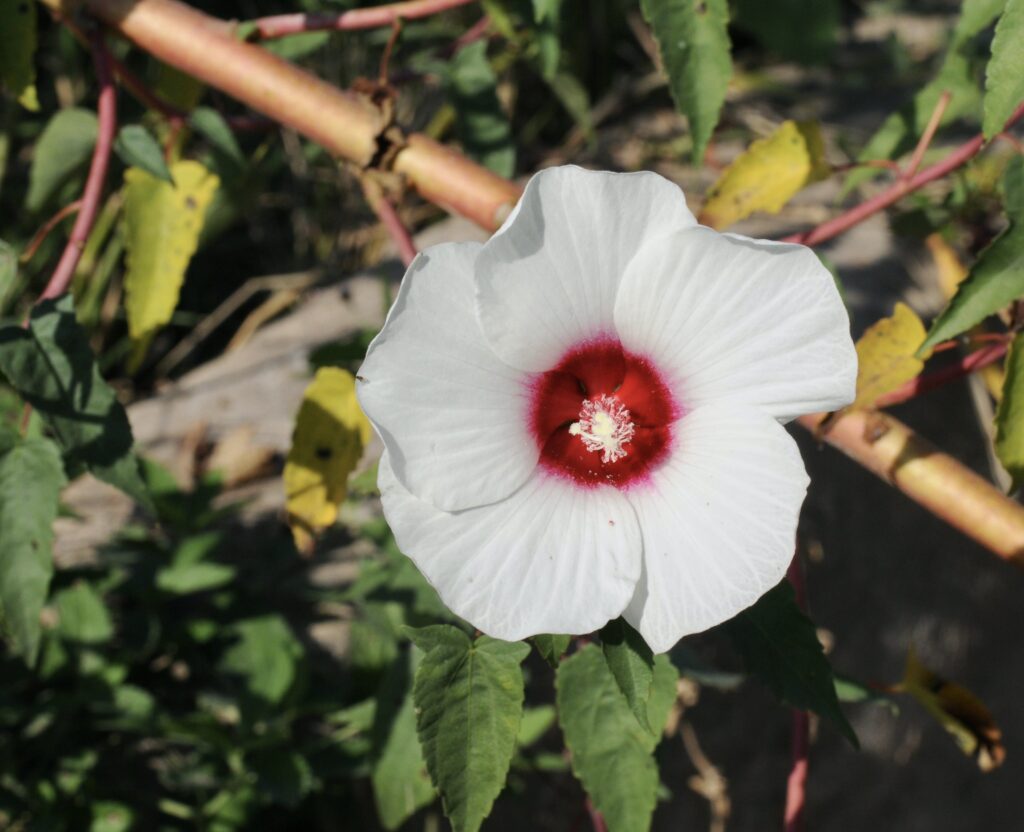
Knowing when your Halberd-leaf Rosemallow starter plants are ready for planting outdoors is key to their success. These plants do best when transplanted after they have developed several sets of true leaves and are strong enough to handle outdoor conditions.
Generally, seedlings should be at least 6 to 8 weeks old and grown in larger containers or soil blocks before planting out. This gives their roots time to establish and reduces transplant shock.
It is often beneficial to start seeds earlier—up to 10 to 12 weeks before the last expected frost—so plants can mature indoors before going outside.
Ensure that nighttime temperatures consistently stay above 50 degrees Fahrenheit and that any risk of frost has passed before moving your plants outdoors.
Hardening Off Halberd-leaf Rosemallow Plants
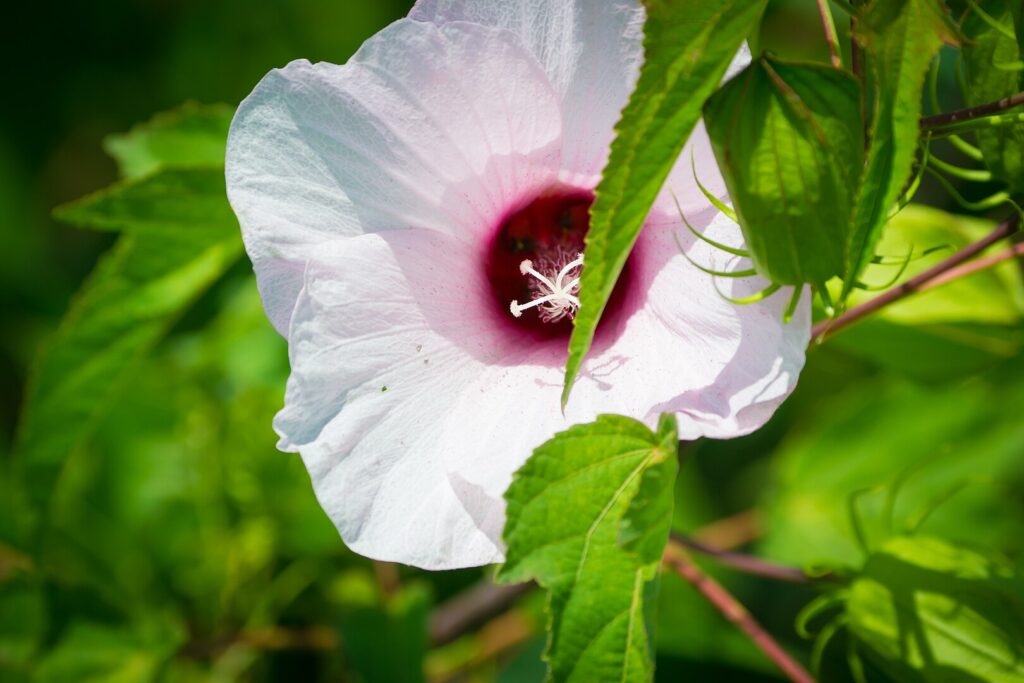
Hardening off prepares your Halberd-leaf Rosemallow seedlings for the outdoor environment by gradually acclimating them to sunlight, wind, and fluctuating temperatures.
Start this process about one to two weeks before transplanting.
Begin by placing the seedlings in a sheltered, shady spot outdoors for a few hours each day. Over the course of the week, slowly increase their exposure to direct sunlight and outdoor conditions. Avoid harsh midday sun during the first few days to prevent leaf scorch.
Make sure to bring the plants indoors or protect them during cold nights or extreme weather. Reduce watering slightly to encourage stronger root growth, but keep the soil moist.
After about 7 to 10 days of this gradual transition, the seedlings will be ready to thrive when planted in their permanent garden location.
Planting Out Halberd-leaf Rosemallow Plants
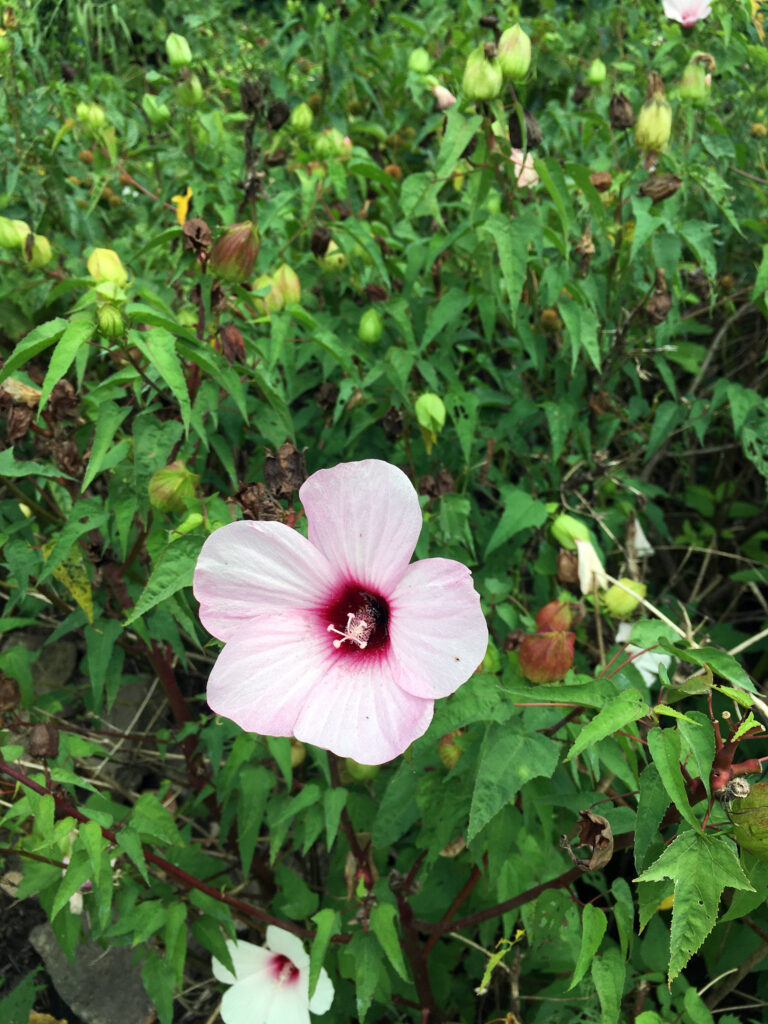
Planting Halberd-leaf Rosemallow successfully involves careful attention to placement and aftercare. Follow these step-by-step instructions to give your plants the best start in the garden.
- Prepare the planting holes so they are slightly wider and deeper than the root ball of each seedling. Plant the Halberd-leaf Rosemallow at the same depth it was growing in the container to avoid burying the stem too deeply.
- Space the plants about 2 to 3 feet apart to allow room for growth and good air circulation, which helps reduce disease risk.
- Apply a layer of organic mulch around the base of each plant, such as shredded bark or compost. Mulching conserves soil moisture, suppresses weeds, and moderates soil temperature.
- Water thoroughly immediately after planting to settle the soil around the roots. Keep the soil consistently moist during the first few weeks to help establish the plants but avoid waterlogging. Once established, Halberd-leaf Rosemallow is fairly drought-tolerant and benefits from deep, less frequent watering.
By following these steps, your Halberd-leaf Rosemallow plants will develop strong roots and healthy growth in their new garden home.
Halberd-leaf Rosemallow Plant Care
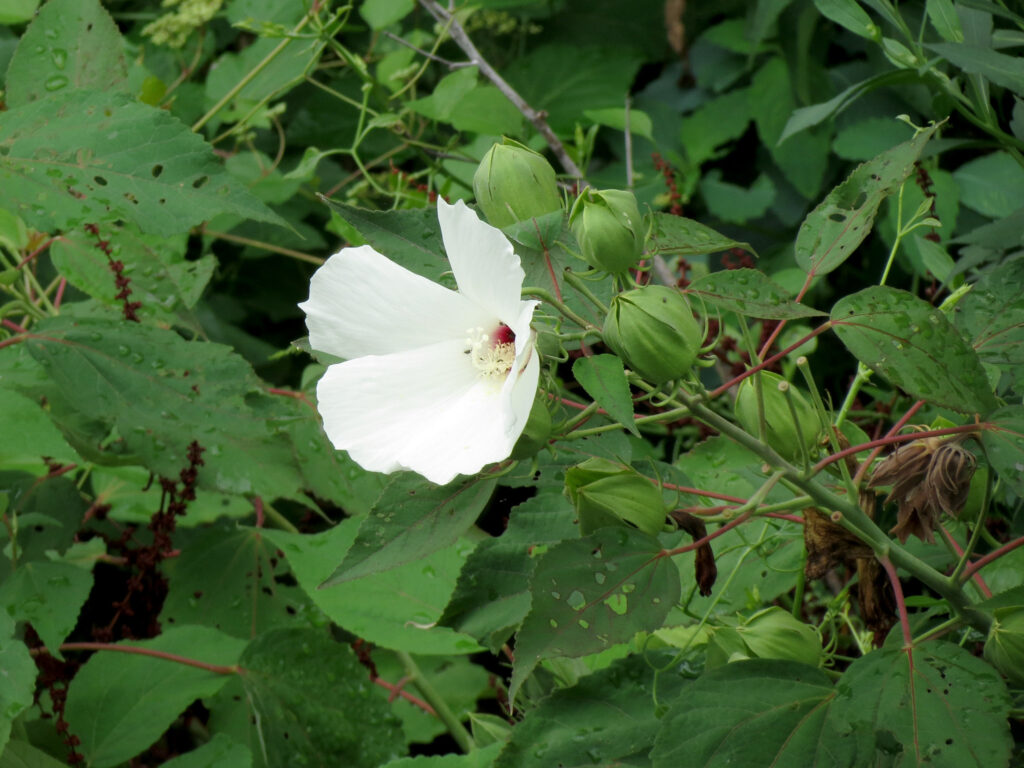
Proper care throughout the growing season ensures healthy Halberd-leaf Rosemallow plants that thrive and bloom beautifully.
Watering
Halberd-leaf Rosemallow prefers consistently moist soil, especially during the first growing season as it establishes roots. Water deeply once or twice a week, depending on rainfall and temperature. Avoid letting the soil dry out completely, but be careful not to overwater, as soggy conditions can lead to root rot.
Feeding
Apply a balanced, slow-release fertilizer in early spring to support healthy growth. A fertilizer with equal parts nitrogen, phosphorus, and potassium (such as 10-10-10) works well. You can also supplement with occasional feedings of liquid fertilizer every 4 to 6 weeks during the growing season to encourage vigorous flowering.
Weeding
Keep the area around your Halberd-leaf Rosemallow plants free of weeds to reduce competition for nutrients and water. Mulching helps suppress weeds and maintain soil moisture, reducing the need for frequent manual weeding.
Pest Control
Halberd-leaf Rosemallow is generally resistant to most pests, but occasional problems with aphids or spider mites may occur. Use insecticidal soap or neem oil to control infestations while avoiding harsh chemical insecticides that could harm beneficial insects. Regularly inspect your plants to catch pest problems early.
Tips and Tricks for Growing Halberd-leaf Rosemallow
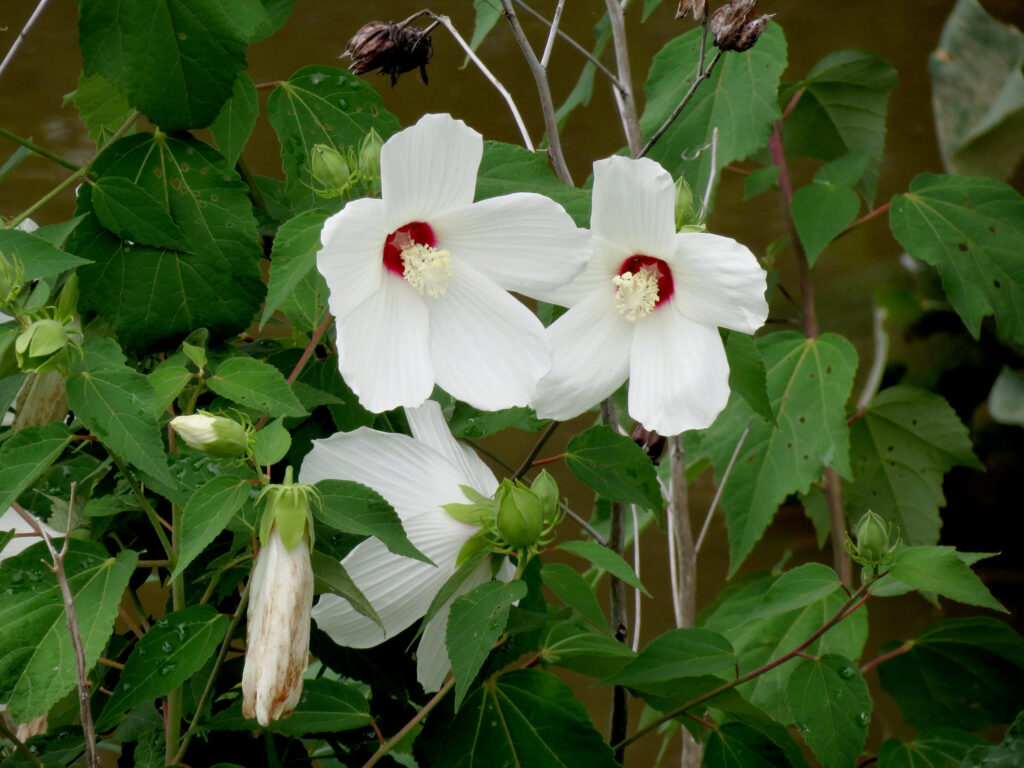
Halberd-leaf Rosemallow is a low-maintenance native perennial, but a few thoughtful techniques can help gardeners get the most from this striking plant.
Pinching Back
Pinching back is not required, but it can be beneficial for young Halberd-leaf Rosemallow plants. If started early enough in the season, lightly pinching the growing tips once or twice can encourage a fuller, bushier shape and promote more branching, which may result in additional blooms.
Staking and Support
Halberd-leaf Rosemallow plants can grow quite tall—often reaching 4 to 6 feet—and may require staking or light support, especially in areas prone to wind or heavy rainfall. Gardeners growing them in exposed or open areas may want to install discreet plant supports early in the season before the stems become woody.
Additional Growing Tips
Halberd-leaf Rosemallow thrives best in consistently moist conditions, so gardeners with rain gardens, swales, or the edges of ponds or ditches will find this plant especially rewarding.
Even in traditional garden beds, watering deeply and mulching generously will help mimic the moisture levels it prefers in the wild. Avoid planting in dry, sandy soils unless irrigation is available.
This species is also highly attractive to pollinators. For best results, plant in clusters or groupings to increase visual impact and draw more butterflies and bees.
Deadheading is not necessary, but removing spent blooms can tidy the plant and may encourage a second, lighter wave of flowering later in the season.
Halberd-leaf Rosemallow Winter Care
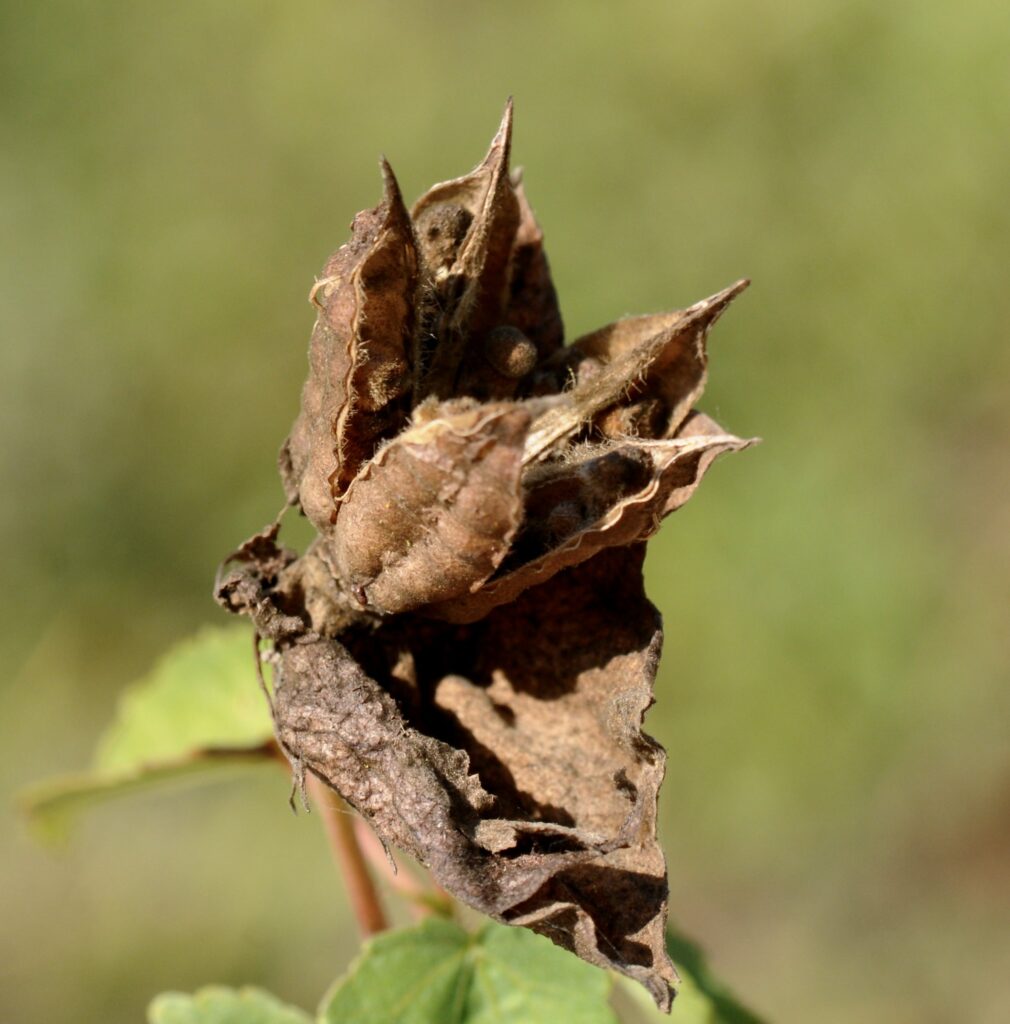
As a hardy perennial native to much of the central and eastern United States, Halberd-leaf Rosemallow is well adapted to survive winter temperatures in USDA Zones 4 through 9. Once cold weather sets in, the above-ground portions of the plant will naturally die back, leaving only dry, woody stems behind.
This dormancy is a normal part of the plant’s life cycle and helps it conserve energy for regrowth in the spring.
To prepare Halberd-leaf Rosemallow for winter, allow the stems to remain standing through fall and into early winter. This not only protects the crown of the plant from sudden freezes but also provides shelter for overwintering insects and seed for birds, contributing to a healthy garden ecosystem.
Once the plant has fully gone dormant and experienced several hard frosts, you may cut the stems back to about 2 to 3 inches above the ground. If you prefer a more naturalized approach, you can leave them standing until late winter or early spring and trim them just before new growth emerges.
When spring arrives, Halberd-leaf Rosemallow will be one of the later plants to wake up, often waiting until the soil is consistently warm before sending up new shoots. Be patient and resist the urge to dig around the base too early.
As new growth begins, apply a layer of compost around the crown and refresh mulch to suppress early weeds and retain moisture. With proper care, the plant will quickly regain its full stature and begin another season of vigorous growth and flowering.
Bring Wild Beauty Home by Growing Halberd-leaf Rosemallow
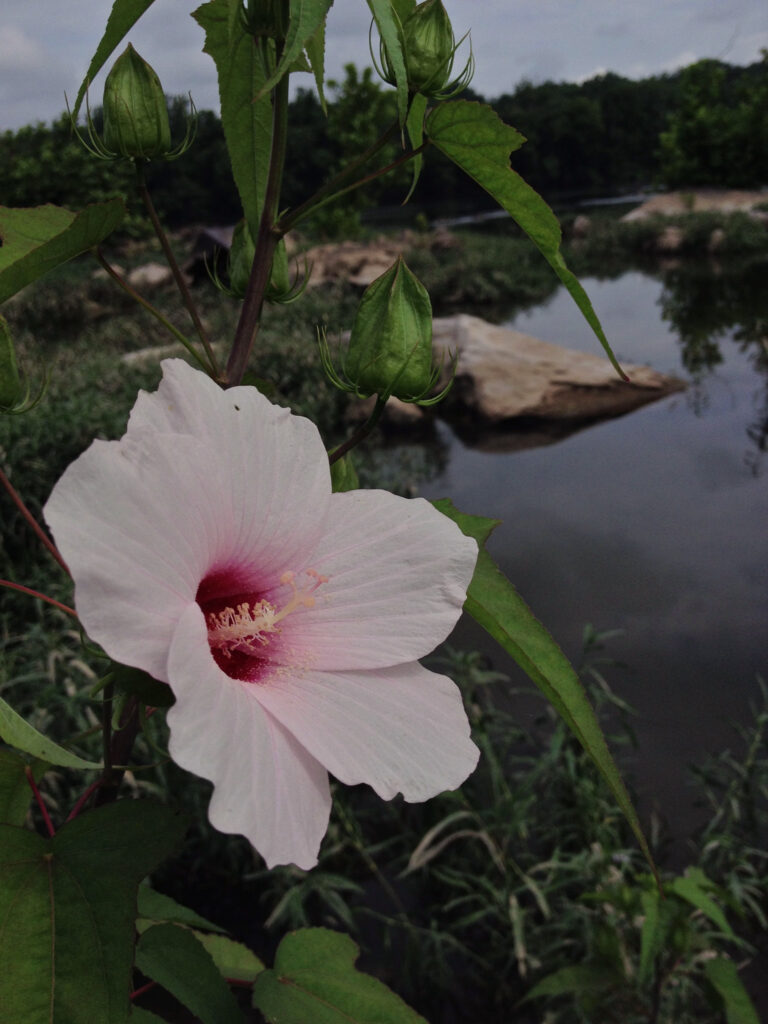
Halberd-leaf Rosemallow is more than just a striking native wildflower—it’s a hardy, adaptable, and pollinator-friendly perennial that adds grace and biodiversity to any garden. Its impressive stature, hibiscus-like blooms, and tolerance for damp conditions make it especially valuable in rain gardens, pond edges, and naturalized plantings.
Whether you’re looking to support native bees, attract butterflies, or simply enjoy show-stopping summer blooms, this plant delivers with minimal effort once established.
Its ability to return each year with vigor means you’ll enjoy its presence long after the initial planting. With proper preparation, care, and a bit of patience, Halberd-leaf Rosemallow will reward you with season after season of low-maintenance beauty.
If you’re ready to enhance your landscape with a native plant that’s both ornamental and ecologically meaningful, Halberd-leaf Rosemallow is a perfect choice. Start your seeds today, and create a haven for wildlife while adding bold elegance to your garden.
